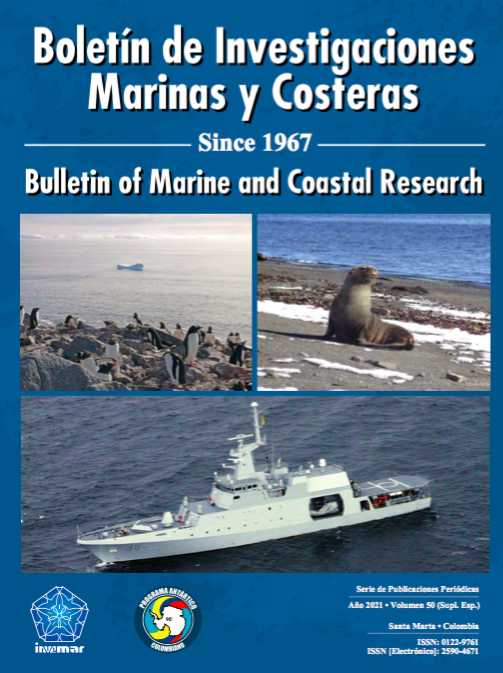Publicado 2021-05-26
Palabras clave
- Sea ice,
- Antarctic Ocean dynamics,
- Diapycnal mixing,
- Gerlache Strait,
- Mixing.
Cómo citar
Derechos de autor 2021 Boletín de Investigaciones Marinas y Costeras

Esta obra está bajo una licencia internacional Creative Commons Atribución-NoComercial-CompartirIgual 4.0.
Resumen
Las medidas de turbulencia en el océano son escasas, especialmente en ambientes como la Antártida. En este trabajo presentamos un mapa de distribución espacial de las difusividades diapicnas y de las características de la columna del agua a través de las tres principales bahías del estrecho de Gerlache. Las medidas fueron registradas durante la quinta expedición colombiana a la Antártida, 2018-2019, usando un perfilador de microestructura vertical en caída libre sobre los primeros 400 m de profundidad, para registrar las fluctuaciones de la cizalla vertical a escalas de disipación (10-3 – 103 m). La difusividad diapicna es alta, entre 1-2 órdenes de magnitud sobre la corriente principal de Gerlache, comparada con el interior de las bahías, con valores que van desde O (log10kρ = -3 m2s-1) hasta O (log10kρ = -5 m2s-1) respectivamente sobre los primeros 400 m. Los valores más elevados de mezcla fueron registrados en la sección sur del estrecho de Gerlache (bahía Flandes) comparados con los valores de la sección norte (bahía Charlotte), indicando la presencia de agua bien mezclada. Hay zonas más activas (Hot Spots) que presentan altos niveles de mezcla turbulenta y pueden ser asociadas con la interacción producida por la entrada de masas de agua como la Upper Circumpolar Depth Water, la Antarctic Surface Water, y la Weddell Sea Deep Water, con el agua que reside en las bahías y la topografía que presenta cada una de estas.
Descargas
Citas
- Cook, A.J., Vaughan, D.G., Luckman, A.J., Murray, T. 2014. A new Antarctic Peninsula glacier basin inventory and observed area changes since the 1940s. Antarctic Science, 26 (6): 614 – 624.
- Jacobs, S., A. Jenkins, H. Hellmer, C. Giulivi, F. Nitsche, B. Huber, and R. Guerrero. 2012. The Amundsen Sea and the Antarctic Ice Sheet. Oceanography. 25 (3): 154 – 163. DOI: 10.5670/oceanog.2012.90.
- Kelley, D. E., Fernando, H. J. S., Gargett, A. E., Tanny, J., Özsoy, E.. 2003. The diffusive regime of double-diffusive convection. Progress in Oceanography. 56 (3 - 4): 461 – 481. DOI: 10.1016/S0079-6611(03)00026-0.
- Kolmogorov, A. N. 1941. The local structure of turbulence in incompressible viscous fluid for very large Reynolds numbers. Proc. R. Soc. Lond. 434: 9 - 13.
- Lencina-Avila Jannine, Goyet Catherine, Kerr Rodrigo, Orselli Iole, Mata Mauricio, Touratier Franck. 2018. Past and future evolution of the marine carbonate system in a coastal zone of the Northern Antarctic Peninsula. Deep-Sea Res. II. 149: 193 - 205. DOI:10.1016/J.DRS2.2017.10.018.
- Masson, D. 2002. Deepwater renewal in the Strait of Georgia. Estuarine Coastal and Shelf Science. 54: 115 - 126.
- Nasmyth, P. W. 1970. Oceanic turbulence. University of British Columbia. 71 p. DOI: 10.14288/1.0084817.
- Nikurashin, M., and R. Ferrari. 2011. Global energy conversion rate from geostrophic flows into internal lee waves in the deep ocean. Geophys. Res. Lett. 38: L08610. DOI: 10.1029/2011GL046576.
- Oakey, N. S. 1982. Determination of the rate of dissipation of turbulent energy from simultaneous temperature and velocity shear microstructure measurements. J. Phys. Oceanogr. 12: 256 – 271. DOI: 10.1175/1520-0485.
- Ross, T., Lavery, A. 2010. Acoustic detection of oceanic double-diffusive convection: a feasibility study. J. Atmos. Ocean. Tech. 27 (3): 580 - 593.
- Ruddick, Barry. 1985. A practical indicator of the stability of the water column to double-diffusive activity. Deep-Sea Res. 30 No. 10A: 1105 - 1107.
- Savidge, D. K., Amft, Julie A. 2009. Circulation in the West Antarctica Peninsula derived from 6 years of shipboard ADCP transects. Deep-Sea Res. I 56: 1633 - 1655.
- Sheen, K. L., Brearley, J., Naveira Garabato, Smeed D., Waterman S., Ledwell J., Meredith M., St. Laurent L., Thurnherr A., Toole J., and Watson A. 2013. Rates and mechanisms of turbulent dissipation and mixing in the Southern Ocean: Results from the Diapycnal and Isopycnal Mixing Experiment in the Southern Ocean (DIMES). J. Geophys. Res. Oceans. 118: 2774 – 2792. DOI: 10.1002/jgrc.2021.
- Smith, D. a., Hofmann E. E., Klinck, J. M., Lascara, C. M. 1999. Hydrography and circulation of the West Antarctic Peninsula continental shelf. Deep-Sea Res. I 46: 925 - 949.
- Stewart, R. 2008. Introduction to Physical Oceanography. Department of Oceanography. Texas A&M University. 345 p.
- Thorpe S. A. 2005. The turbulent ocean. Cambridge University Press. Cambridge. 439 p.
- Valkonen, T., Vihma, T., Doble, B. 2008. Mesoscale modeling of the atmosphere over Antarctic sea ice: A late autumn case study. Mon. Weather Rev. 136: 1457 – 1474.

